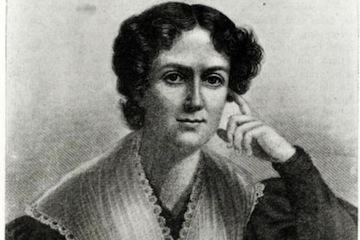Frances Wright, an Early American Feminist Radical
As a teenager in Scotland, Frances Wright read books about the land of liberty called the United States. As an adult she realized her dream of moving to the new country. Her projects included an advocacy for abolitionism, social and sexual equality for women, universal education, freethinking, and the rights of labor. She was renowned in her time, meeting Presidents and luminaries of American life. Her most famous project was a farm in Tennessee, dedicated to proving her concepts on the gradual emancipation of slaves. Called Nashoba, it was a utopian project from the start, and collapsed into ignominy.
Frances Wright's first exposure to the United States came in 1818. In that year, at the age of 22, she embarked upon a tour of the country with her female sister. They landed in New York, were immediately grifted by an innkeeper, thereafter got a play produced anonymously (Wright was nothing if not attractive, confident, and persuasive), and saw it receive acclaim with the public before it was revealed to be the work of a woman. Such adventures set the tone for Wright's life in America. Undeterred, she set about interviewing as many Americans as she could in various regions of the country, taking copious notes, and turning the material into a popular book. The resulting work, Views of Society and Manners in America, won her a national reputation.
Wright returned to the United States on a more permanent basis in the 1820s. She was friends (and maybe more?) with the Marquis de Lafayette. She met James Monroe, Andrew Jackson, Henry Clay, Thomas Jefferson, and others. Her attentions turned to the brutality of slavery. Slavery was the blackest mark she witnessed in a land that touted the wonders of liberty. She believed that if she devised a system to prove that gradual emancipation could be effected without harming the slaveowner, then the rationale for slavery would collapse.
The result of this belief was the Nashoba community, near Memphis, Tennessee. Wright invested no small amount of money in purchasing 2,000 acres and eight slaves, and immediately set up a program whereby the slaves would earn their freedom. Wright was in accord with the popular opinion of her time in believing that once free, the former slaves should thereafter live in Haiti or Liberia. Freed slaves from Nashoba were not allowed to remain in the United States.
Whites and blacks lived and worked in close proximity at Nashoba, but the project's ultimate fate was failure and disaster. Wright caught malaria and nearly died. In her absence, another white resident took a biracial lover and publicly stood by the relationship. All decisions and management of the community remained in the hands of its white members, and the slaves still worked as slaves. In this case, they worked as the slaves of masters who were incompetent farmers and quixotic political theoreticians. To purchase their freedom the slaves needed to earn the sum of $6,000 a piece -- enormous by the standards of the time. The commune became a laughingstock and utterly failed to meet its objectives. Finally, in 1830, Wright gave up and transported her slaves to Haiti, and then freed them.
By the 1830s, Wright had become famous and then infamous. She gave public speeches to large audiences, but many turned out simply to jeer and harass her. Her views on women's equality and sexual liberty were far out of step with the era. Her history with Nashoba was another mark against her reputation. And her hostility to religion led to harsh denunciations from broad swaths of society. When she died in 1853, her name was no longer fashionable in American dialogue, and it seems not to have been overshadowed by the deeds of other women of her day.
